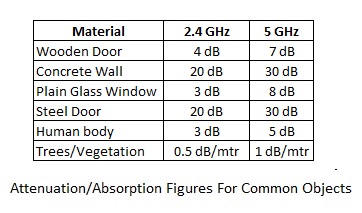Everyone faces WiFi signal issues at home, office or at public places while trying to connect to the Internet. Wireless communication is a complex science that has been made user-friendly for humans. In this post, we will focus exclusively on the wireless signal propagation phenomenons of Absorption, Reflection, Diffraction, Scattering, Polarization, Refraction & Free space path loss that affects every wireless communication at various degrees.
Absorption
In an enterprise, most of the office materials will absorb some WiFi signal when it is traveling from the Access Point to the end-user devices. Wooden walls absorb relatively small amounts of signals but brick or concrete walls will absorb more, depending on the absorption coefficient value, thickness etc. Glass doors and green vegetation can also absorb radio signals. In fact human body, which is made up of 70% water, absorbs radio signals. Hence people density should also be taken into consideration when planning a WLAN network.

Reflection
As like visible light reflecting from surfaces, WiFi signals can also bounce off from metal doors, furniture, windows, etc. Signal reflections can be in any number of directions and these reflections may ultimately interfere with signal quality itself. This phenomenon is called as multi-path fading. The WiFi signal from a transmitter may get reflected into multiple copies/components in the propagation path. The receiver will receive multiple copies of the original signal. It will then attempt to reconstruct the original signal. This process may have a positive or negative effect as various signal components may enrich or degrade signal quality. Rapid frequency shifting can also be noticed under such conditions.
Diffraction
This is due to the radio signal encountering a sharp edged obstacle or a slit that is comparable in size to its wavelength. Normally it refers to the bending of signals around an object. Outdoor environments usually present such challenges. There will be energy loss in signals reaching behind the object. Higher the frequency, higher will be the loss as lower wavelengths won’t reach the shadows as effectively as higher wavelengths.
Scattering
Radio wave scattering occurs when signals hit a rough surface. The signals, instead of being reflected, gets scattered in many directions. Scattering can also be caused by dust, humidity, rain, vegetation etc. Scattering reduces the quality of received signals.

Polarization
Antennas provides higher gain, signal direction and polarity to radio waves. Here polarity is the orientation of electromagnetic field of the signal. Vertical & Horizontal polarization are 2 simplest forms of polarizations. If WiFi signal transmitter and receiver polarization are different, then lots of difficulty will be faced in signal reception. Particularly in point-to-point connectivity, engineers must be sensitive to polarization effects, as antennas can communicate with each other only if they are in the same polarization plane.

Refraction
Due to different refractive index of materials, there will be a change in direction or bending of the radio waves due to change in the transmission medium. This causes signal phase shifts. Normally glass doors can cause refraction in an office environment and the strength of the final WiFi signal coming out of glass may stand attenuated. Due to this, users may experience low data rates and even packet drops. In point-to-point links traveling long distances, changes in atmospheric refractive indexes can also affect communications as signals may get deviated from the original path.
Free Space Path Loss
It is the natural loss of signal strength that increases with the distance traveled by a radio wave. This happens because the signal spreads more and more in the air as the distance from source increases.
Above discussed are some of the Wireless Signal propagation phenomenons that can affect every wireless communication, including office WiFi and Point-to-point connectivities. Enough consideration should be given by wireless engineers to these factors while designing and implementing Wireless networks.
